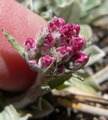860806 Antennaria rosea Greene
- Greene, Pittonia 3: 281 (1898). Lectotype (NDG): U.S.A.: Idaho, Kootenai Co., Mountain Meadows, leg. Leiberg 646 (Bayer 1989b: 56).
2n=
(1) 28 (4x). - North America (W). - Chinnappa (1986).
(2) 42 (6x). - North America. - Bayer and Stebbins (1987); Chmielewski and Chinnappa (1988).
(3) 56 (8x). - North America. - Several reports.
(4) 60-<70 (ca. 9x). - North America. - At least three reports.
(5) 70 ca. 72 (10x). - North America. - At least four reports.
(6) 126 (18x). - U.S.A. (W). - Löve and Kapoor (1968); Löve et al. (1971).
Bayer (2006) reported the chromosome numbers of 2n = 42, 56, and 70 for this species, which means that he rejected at least the tetraploid number reported by Chinnappa (1986) and the 18-ploid numbers reported by Á. Löve and collaborators.
Geography: North American.
Notes: Antennaria rosea s. lat. is a large, hybridogeneous, polyploid, and agamospermous aggregate distributed in temperate to low arctic North America and Greenland. Bayer (1989b) considered it one polymorphic species. Bayer reported male plants to be unknown (but see the comment above about staminate A. isolepis, a synonym of subsp. pulvinata). Three of the four subspecies accepted by Bayer reach the Arctic. The fourth, subsp. arida (E.E. Nelson) R.J. Bayer, approaches the Arctic in the Yukon Territory. See the revisions of Chmielewski and Chinnappa (1988) and Bayer (1989b). Numerous previously species names have been included in the synonymy of these four subspecies.
Bayer (1993, 2006) stated this complex species to have developed from 6-9 sexual progenitor species, all non-arctic. Bayer (2006) indicated that each of the subspecies were most closely related to different combinations of assumed progenitors: subsp. confinis to A. pulchella and A. umbrinella, subsp. pulvinata to A. aromatica, and subsp. rosea to A. corymbosa and A. racemosa. Arguments can be forwarded for treatments either as a complex species (due to an evolutionary reticulum, Bayer's interpretation) or alternatively as a series of species (due to different combinations of sexual progenitors). We provisionally follow Bayer's treatment.
Antennaria rousseaui A.E. Porsild, Canad. Field-Naturalist 63: 80 (1949) holotype (DAO): Canada: Quebec, Riviere Payne, vers 5917 lat N, 07. Aug. 1948, leg. J. Rousseau 991, is a local species reported from Ungava and Labrador. Bayer (2006) considered this name to belong to an "early-generation interspecific hybrid", probably A. alpina x A. rosea.
-

''Antennaria rosea'' in Lee Canyon near junction of 156 and 158, Spring Mountains, southern Nevada (elev. about 2400 m)
Source: Stan Shebs at Wikispecies
Higher Taxa
- Antennaria [8608,genus]